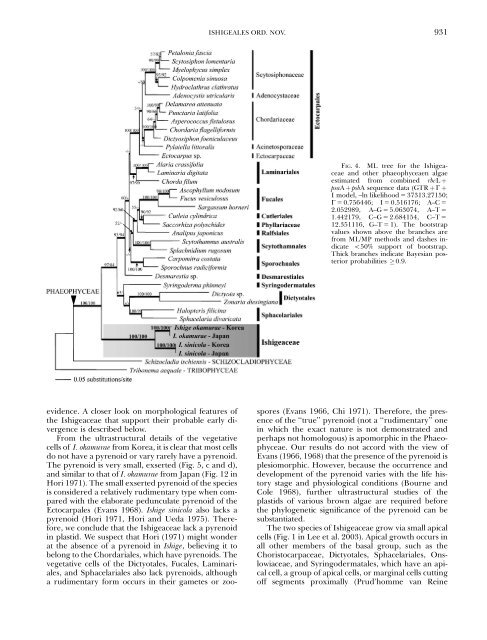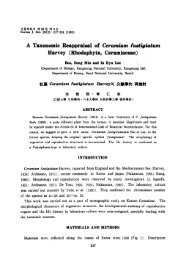A NEW BROWN ALGAL ORDER, ISHIGEALES (PHAEOPHYCEAE ...
A NEW BROWN ALGAL ORDER, ISHIGEALES (PHAEOPHYCEAE ...
A NEW BROWN ALGAL ORDER, ISHIGEALES (PHAEOPHYCEAE ...
You also want an ePaper? Increase the reach of your titles
YUMPU automatically turns print PDFs into web optimized ePapers that Google loves.
evidence. A closer look on morphological features of<br />
the Ishigeaceae that support their probable early divergence<br />
is described below.<br />
From the ultrastructural details of the vegetative<br />
cells of I. okamurae from Korea, it is clear that most cells<br />
do not have a pyrenoid or vary rarely have a pyrenoid.<br />
The pyrenoid is very small, exserted (Fig. 5, c and d),<br />
and similar to that of I. okamurae from Japan (Fig. 12 in<br />
Hori 1971). The small exserted pyrenoid of the species<br />
is considered a relatively rudimentary type when compared<br />
with the elaborate pedunculate pyrenoid of the<br />
Ectocarpales (Evans 1968). Ishige sinicola also lacks a<br />
pyrenoid (Hori 1971, Hori and Ueda 1975). Therefore,<br />
we conclude that the Ishigeaceae lack a pyrenoid<br />
in plastid. We suspect that Hori (1971) might wonder<br />
at the absence of a pyrenoid in Ishige, believing it to<br />
belong to the Chordariales, which have pyrenoids. The<br />
vegetative cells of the Dictyotales, Fucales, Laminariales,<br />
and Sphacelariales also lack pyrenoids, although<br />
a rudimentary form occurs in their gametes or zoo-<br />
<strong>ISHIGEALES</strong> ORD. NOV. 931<br />
FIG. 4. ML tree for the Ishigeaceae<br />
and other phaeophyceaen algae<br />
estimated from combined rbcL þ<br />
psaA þ psbA sequence data (GTR þ G þ<br />
I model, –ln likelihood 5 37313.27150;<br />
G 5 0.756446; I 5 0.516176; A–C 5<br />
2.052989, A–G 5 5.063074, A–T 5<br />
1.442179, C–G 5 2.684154, C–T 5<br />
12.351116, G–T 5 1). The bootstrap<br />
values shown above the branches are<br />
from ML/MP methods and dashes indicate<br />
o50% support of bootstrap.<br />
Thick branches indicate Bayesian posterior<br />
probabilities 0.9.<br />
spores (Evans 1966, Chi 1971). Therefore, the presence<br />
of the ‘‘true’’ pyrenoid (not a ‘‘rudimentary’’ one<br />
in which the exact nature is not demonstrated and<br />
perhaps not homologous) is apomorphic in the Phaeophyceae.<br />
Our results do not accord with the view of<br />
Evans (1966, 1968) that the presence of the pyrenoid is<br />
plesiomorphic. However, because the occurrence and<br />
development of the pyrenoid varies with the life history<br />
stage and physiological conditions (Bourne and<br />
Cole 1968), further ultrastructural studies of the<br />
plastids of various brown algae are required before<br />
the phylogenetic significance of the pyrenoid can be<br />
substantiated.<br />
The two species of Ishigeaceae grow via small apical<br />
cells (Fig. 1 in Lee et al. 2003). Apical growth occurs in<br />
all other members of the basal group, such as the<br />
Choristocarpaceae, Dictyotales, Sphacelariales, Onslowiaceae,<br />
and Syringodermatales, which have an apical<br />
cell, a group of apical cells, or marginal cells cutting<br />
off segments proximally (Prud’homme van Reine




